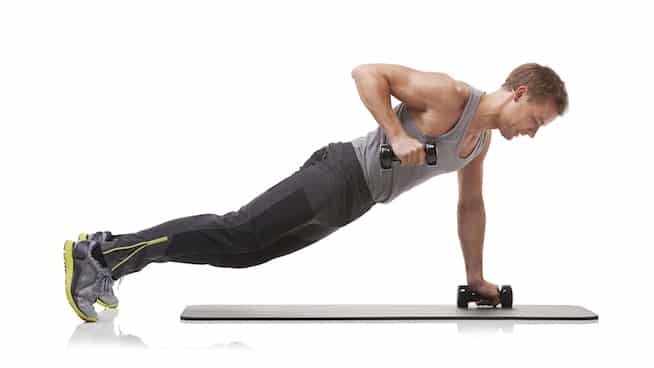Renegade Row is a multi-purpose, multi-joint exercise that increases strength in the back, shoulders, triceps, and biceps.
This two-in-one exercise will also actively engage the core throughout the range of motion.
Renegade row (also known as a plank row) is almost a variation of the dumbbell row.
It’s designed to target the upper back and, like a plank, designed to target the core.
Benefits
The renegade row is an excellent exercise to target the entire upper body and core.
The plank portion of the exercise requires the engagement of the deep stabilizing muscles of the abdominals, spine, shoulders, and hips.
While the row portion of the exercise targets the upper back and arms, including the larger muscles of the upper back—the lats and rhomboids—as well as the biceps and shoulders.
What’s unique to the renegade row, separate from the plank and row, is the anti-rotational engagement of the obliques.
As you draw one dumbbell up toward your chest, your body’s natural inclination is to twist upward.
The same-side hip starts twisting toward the ceiling. This twisting motion reduces the focus on the upper back.
This type of anti-rotational strength is highly beneficial when it comes to functional fitness.
Often, low-back injuries take place when the spine is pulled out of alignment during an everyday or unexpected movement.
For instance, your low back might become injured if you bend down to pick something up from the floor, and your spine twists unexpectedly, causing pain.
Anti-rotational core strength helps keep your spine in alignment during this type of movement.
Ultimately helping protect your low back from potential pain or injury.
Step-by-Step
To perform the renegade row, all you need is enough space to hold a plank and a set of dumbbells.
- Place the dumbbells on the floor, positioned so that when you set up in a plank position.
- The dumbbells are roughly shoulder-distance apart and the handles of the dumbbells are parallel to one another.
- Start on your hands and knees in a tabletop-like position, gripping one dumbbell with each hand.
- Your hands should be aligned beneath your shoulders and your knees under your hips.
- Step your feet behind you to enter a full plank position, your body supported by your hands and the balls of your feet.
- Check your form here—your body should form a straight line from your heels to your head with your core engaged and tight.
- Position your feet so they’re roughly hip-distance apart to offer more balance and support to the exercise.
- Inhale and shift your weight slightly to your left side so more of your weight is supported by your left palm.
- Your body shouldn’t twist—make sure both hips and shoulders remain squared to the floor.
- Squeeze your right shoulder blade toward your spine and draw the dumbbell held in your right hand toward your chest.
- Bending your elbow as you draw the dumbbell toward you.
- Exhale as you lift the dumbbell.
- Check your form at the top of the movement—your hips and shoulders should still be squared to the floor.
- The dumbbell should be pulled all the way to your right chest/shoulder.
- Your right elbow should be pointing up and toward the back of the room.
- Lower the dumbbell slowly to the floor, returning it to the starting position.
- Shift your weight to the right side and repeat the exercise, this time drawing the left dumbbell to your left chest/shoulder. This completes one full repetition.
- Complete the desired number of repetitions and exit the exercise by lowering your knees back to the floor before releasing the dumbbells and sitting up.
Mistakes
Most of the mistakes associated with the renegade row are those common with either the plank or the row.
If you’re familiar with these common mistakes and how to fix them, you shouldn’t have a problem identifying and correcting the mistakes associated with the renegade row.

